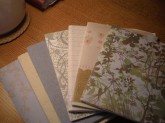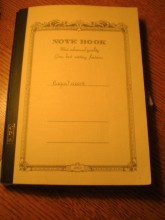Journaling with Words and Images
The first in a series of interviews with Joan Gregory about Art Journaling

I met Joan in a course I was taking. One day she happened to bring her journal, which was filled with quotes, drawings, and collage as well as writing and notes. Several of us were interested enough that she agreed to do a short workshop for us before the class started one day. In the workshop we learned how to make a simple book and how to work with special papers and decorative elements. I loved it and asked her to talk to me more about this type of work, Art Journaling.
What’s the difference between the dear diary-style we learned as kids, which was all words, and art journaling?

You could look at it as art with writing or writing with art. Some people are more word oriented and start off writing and then add art, and others start off with painting, photographs or art and then add words. Another way of describing the different types of journaling methods could be writing- focused or art-focused. The old adage of a picture is worth a thousand words holds true because the images, drawings or collage that you add to your journal also say something about who you are. In fact the images you choose link you to your intuitive and unconscious self maybe more so than the words you write. The art- focused journal relies on the images to tell the story, but there are no hard and fast rules. It’s good to start without an idea one way or the other. Just begin with whatever focus you are comfortable with and let the process take you. The fewer guidelines you have the more likely you’ll be to enjoy journaling and continue with it.
What if you don’t consider yourself an artist?
You don’t need to be a trained artist to be creative, just like you don’t need to have a Masters in English Literature to keep a journal. Besides, we are all creative beings. Like Rumi says, “Inside you there’s an artist you don’t know about”. What’s needed, as in all endeavors you have an interest in, is not how you do it, whether it be writing or art, but that you do it. Also, I use the word ‘art’ very loosely. If you can use scissors and glue and crayons you can create an art journal! Shelve the inner critic.
How did you get started?
Like any young girl I started with a diary at about eight or nine years old, but even before diaries I think we wrote in autograph books. When I was about twelve and going through adolescent angst I started writing poetry, but the actual journal work that I do now didn’t begin until 2001 after buying Julia Cameron’s book, The Artist’s Way. I started doing morning pages, as she suggests in the book, and did the stream of consciousness kind of writing for several years. I found that I did a lot of complaining, not that there’s anything wrong with that, obviously I felt the need to express myself in that manner and much has been written about why that style of writing is helpful, but the bottom line is that it got me writing daily (for the most part).
I graduated from individual pages to the ‘book’ format in August 2004 when I made a conscious decision to keep a journal. The intention for the book came from The Purpose of Your Life, An Experiential Guide by Carol Adrienne where she suggests that you jot down anything that you overhear, think about, read or see that catches your attention more than usual that day; things that excite, delight, or encourage you or a brief description of someone you admire and why. My goal was to write in the morning and again at the end of the day for a month. Manageable, I thought, but soon enough realized I had been a tad overzealous and guilt became my companion as days would go by with no entries. So I relaxed the criteria. This was the first creative thing I had committed to in a long time. The best news was that I persevered.
 When you start it’s important to pick something for your journal that’s pleasing to you. Your words are a gift to yourself and you want to wrap them in something special. What drew me to my first journal were the black and cream graphics, the quality of the paper, and the cover, which encouragingly says, “Notebook – Most advanced quality Gives best writing features”. It reminded me of the scribblers that were handed out at the beginning of each new subject in elementary school. They too were cream and they had a maple leaf on the cover, the times table was on the back. The pages were smooth, they smelled of fresh ink. It was a real sensory experience and there was anticipation and excitement about what I would be learning. This time though the subject would be me. I wanted to treat my writing seriously; I wanted to treat my thoughts with respect.
When you start it’s important to pick something for your journal that’s pleasing to you. Your words are a gift to yourself and you want to wrap them in something special. What drew me to my first journal were the black and cream graphics, the quality of the paper, and the cover, which encouragingly says, “Notebook – Most advanced quality Gives best writing features”. It reminded me of the scribblers that were handed out at the beginning of each new subject in elementary school. They too were cream and they had a maple leaf on the cover, the times table was on the back. The pages were smooth, they smelled of fresh ink. It was a real sensory experience and there was anticipation and excitement about what I would be learning. This time though the subject would be me. I wanted to treat my writing seriously; I wanted to treat my thoughts with respect.I have kept a journal in books of assorted sizes and shapes since that time. I still struggle with creativity, but I can look back and see how I’ve progressed and grown, both in my writing and how I choose to embellish the pages. The art journal has become an integral part of my journey through this life and a necessary vehicle for self expression.
I’d like to end this segment with a quote from Virginia Woolf, who in her lifetime filled approximately thirty-two notebooks.
“What sort of diary should I like mine to be? Something loose knit and yet not slovenly, so elastic that it will embrace any thing, solemn, slight or beautiful that comes into my mind. I should like it to resemble some deep old desk, or capacious hold-all, in which one flings a mass of odds and ends without looking. I should like to come back, after a year or two, and find that the collection had sorted itself…into a mould, transparent enough to reflect the light of our life.”
Next time: From words with art to art with words.
